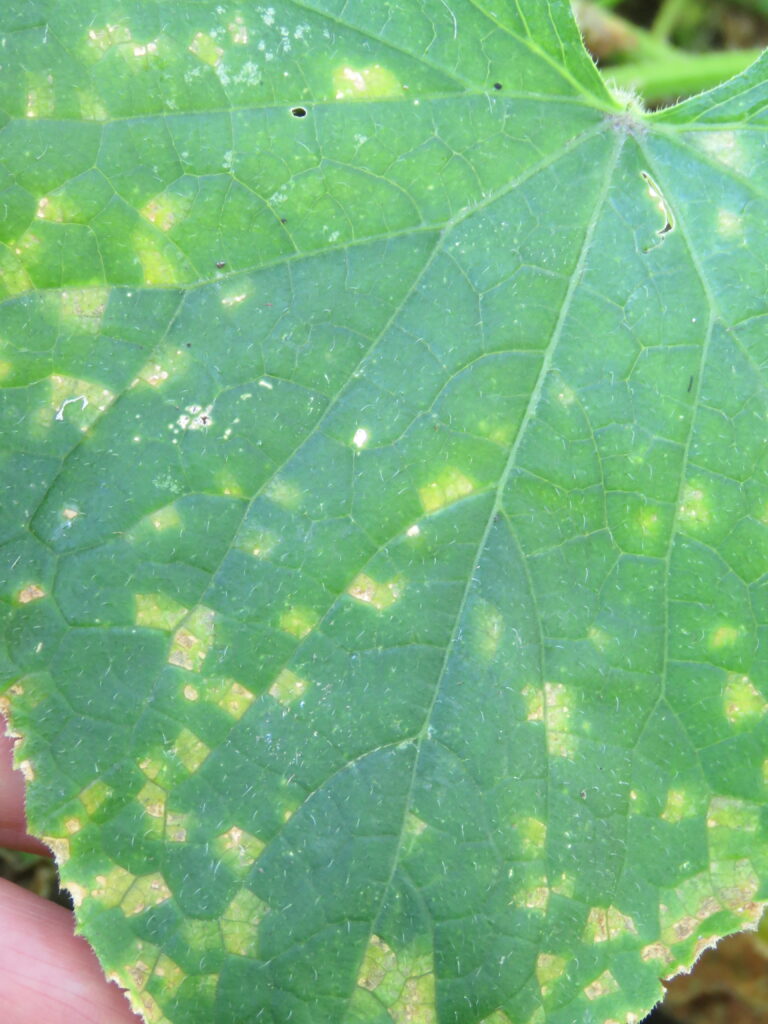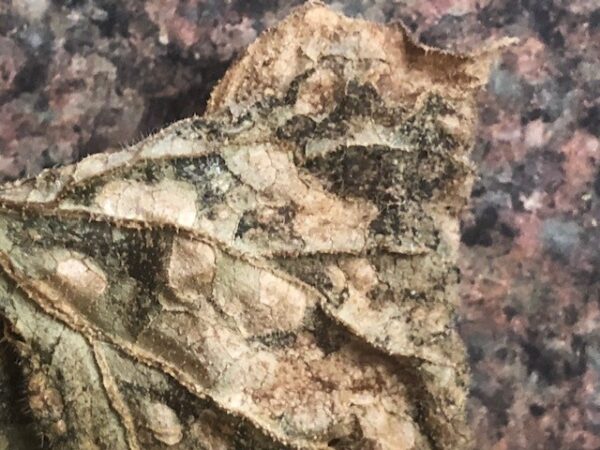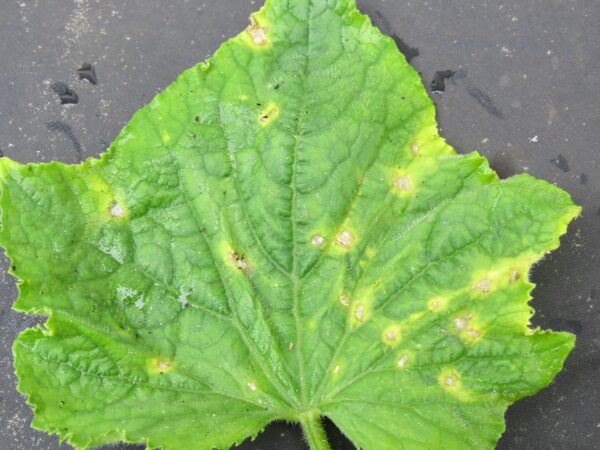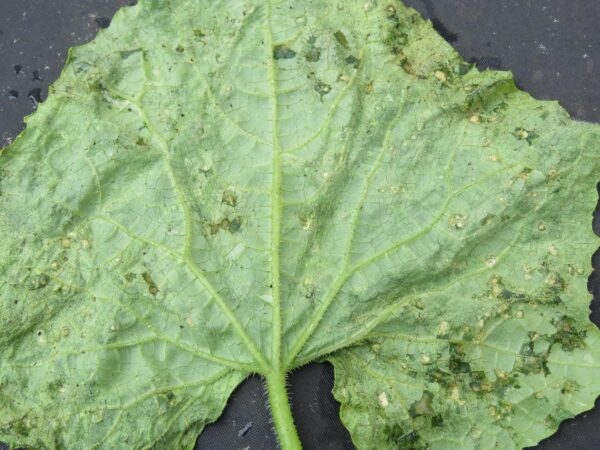
Features
Diseases
Vegetables
Cucurbit disease differentiation
Determining whether the bacterial disease angular leaf spot or downy mildew is afflicting your cucumbers.
November 15, 2023 By Dustin MacLean, horticulturalist and field plant pathologist, Perennia
 Downy mildew on cucumber leaves. Photos courtesy of Dustin MacLean, Perennia.
Downy mildew on cucumber leaves. Photos courtesy of Dustin MacLean, Perennia. Downy mildew has long been considered one of the most important foliar diseases of cucumbers. Downy mildew of cucurbits was not considered a major threat in North America until 2004, when the disease re-emerged and caused significant damage to cucumber varieties previously thought to be resistant to the disease. It first struck Nova Scotia in 2021, blown in from the eastern United States, and has appeared every year since. In areas where cucurbits are grown, downy mildew is an issue due to the suitable climate and high relative humidity. The disease can significantly damage cucurbit crops if there are no effective management techniques in place.

Downy mildew on cucumber leaves. Note the dark, spongy masses on the back of the leaf.
Signs of downy mildew include lesions on the leaves. Angular, vein-delimited lesions that may initially appear slightly chlorotic are typical disease symptoms on cucumbers, and pathogen sporulation is easily visible on the lower leaf surface. Under humid and moist conditions, early infection lesions on cucumbers may appear water-soaked. The bottom leaf surface may appear “dirty” due to the sporangial masses’ grey to purplish colouration when they are present in large numbers. These dark sporangial masses on the underside of the leaf are unique to downy mildew of cucurbits, and the underside of the leaf should always be examined to distinguish between downy mildew of cucurbits and angular leaf spot, a bacterial disease that looks extremely similar on cucurbit leaves. Lesions become more chlorotic and necrotic as the disease worsens, leaves begin to die, and the plant is unable to support fruit production. It is possible that both the quality (misshapen fruit) and quantity of marketable yield will decrease.
The pathogen was found to be resistant to the strobilurin fungicides (FRAC class 11) when it reappeared in 2004. While reports of decreased performance of particular fungicides demonstrates the need for resistance management and the development of new and unique active ingredients, newer downy mildew fungicides have been useful in containing the disease. The use of resistant cultivars and fungicide treatments should be paired with cultural practices to decrease downy mildew incidence. Increased row and plant spacing, drip watering and elevated plant beds with plastic mulch can all assist in limiting the pathogen by reducing leaf wetness, boosting airflow and lowering the relative humidity.
The most common bacterial disease of cucurbits is angular leaf spot, caused by the bacterium Pseudomonas syringae pv. lachrymans. Disease severity is greatest in cucumbers cultivated in warm, humid and semi-humid climates and has been documented in a wide variety of cucurbit crops worldwide. Initially infecting cotyledons and leaves, the disease later spreads to fruits and contaminates seed.
 Angular leaf spot on cucumber leaves.
|
 Angular leaf spot on cucumber leaves. Note the lack of dark, spongy masses on the back of the leaf.
|
Small, wet lesions first emerge on leaves as the disease spreads. The lesions typically grow until they are surrounded by substantial secondary veins in the leaves, which give them an angular appearance. A clear to milky exudate that gathers in a tear on the lower surface of the lesion occurs in conjunction with water-soaking at high relative humidity levels. On or near the lesion, the exudate dries to produce a thin, white crust. The blemishes on the leaves grow dry, tan-brown, and may even drop out. Lesions on cultivars that are sensitive frequently have yellow edges. In areas between lesions, heavily diseased leaves may turn yellow. Later, they may appear frayed or ragged. Petioles, stems and fruits may also experience lesions, showing a white, crusty discharge. This white, milky exudate is the defining characteristic of angular leaf spot and can be used to distinguish the disease from the very similar-looking downy mildew of cucurbits.
Pseudomonas syringae pv. lachrymans is seed-borne, and infestation occurs beneath the seed coat, so the cotyledons are infected upon germination. The bacterium grows and colonizes leaf surfaces in the intercellular spaces of leaves. Raindrops, insects, human field workers and farm equipment can spread the inoculum from leaf to leaf and plant to plant. The bacterium enters stomata and tiny abrasion wounds. It can survive for up to 2.5 years in dry leaves and overwinters in crop debris that has been infected.
Utilizing a thorough set of control measures, angular leaf spot can be reduced. Using seed free of pathogens is the first step in primary control. The number of bacteria in the cucurbit seed is reduced but not eliminated after 20 minutes of treatment with water at 50 C containing different acidic organic compounds. Repeated applications of copper sprays as a foliar protection can be beneficial in warm, humid locations where the bacterium is endemic.
It is essential to determine which of these diseases you are dealing with as, with one being a fungus-like oomycete and the other a bacterium, the control options available (such as fungicides) differ drastically, and one control measure may have no effect on the other disease. By looking at the key differences in these two pathogens, as described above, one can differentiate between these diseases that cause similar symptoms on cucumbers.
In 2023, the Perennia Plant Health Lab opened its doors to accept diseased plant samples, in addition to its virus-testing services. At this time, the focus is on meeting the needs of the Nova Scotia agriculture industry. Perennia’s team of plant disease diagnosticians and specialists, with the aid of conventional and molecular diagnostic tools, can accurately identify what disease you are dealing with and provide tailored recommendations for your unique growing operation.
Print this page